It almost seems as if Rasheed Araeen is preparing to move out of his studio, a suite of whitewashed rooms above a discount furniture store in Cricklewood, northwest London. Geometric paintings are stacked against walls, canvases from his recent Opus series that are shrouded in plastic, through which can be seen a checkerboard pattern painted in diamonds of vibrant colour. An enlarged photograph of a blonde woman, from a Pakistani advertisement for cosmetics, stares out behind them with a mediumistic intensity. More than 60 years of Araeen’s work is being crated up and transported to the Van Abbemuseum in Rotterdam, which is staging a major career retrospective of the artist (until 25 March; the exhibition will tour to MAMCO in Geneva, the BALTIC in Gateshead, and Garage Museum in Moscow). The octogenarian artist, who sports an impressive moustache, sits at a coffee table covered in books, proudly presiding over the shipment.
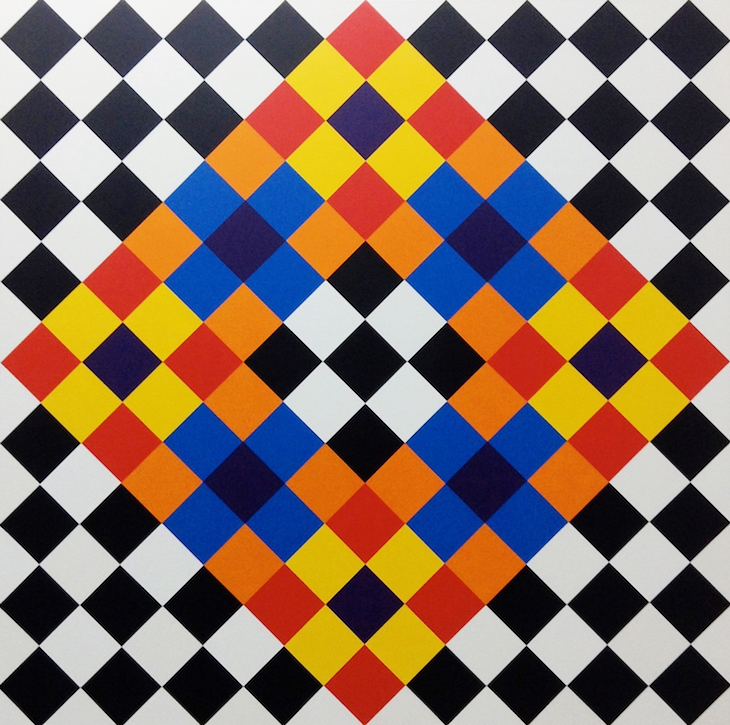
Opus F2 (2016), Rasheed Araeen. Courtesy the artist
He offers me tea and a plate of pakora, made by the wife of one of his assistants, who is busy covering a sculpture made of gridded, interlocking wooden struts with red paint. It is one of 28 that are destined for the atrium of a new building being constructed by the Aga Khan Foundation behind King’s Cross, where they will rise in two rows to a height of 30 metres. Araeen studied civil engineering at the University of Karachi, before emigrating to London in 1964, with dreams of becoming an artist. He immediately fell under the spell of Anthony Caro, who had also trained as an engineer and then dominated the city’s art scene. Araeen’s resulting ‘structures’, designs depicting symmetrical stacks and rows of steel I-beams (Sculpture No.1 and Sculpture No.2, both 1965), cubes and lattice towers, have earned him recognition as a pioneer of British minimalism.
In the early 1970s, having won prizes but – because of his ethnicity – nevertheless struggling to find gallery representation, Araeen had what he describes as ‘a political awakening’. He joined the Black Panther Movement, of which South Asians formed a core, and large-scale photographic collages, like the gridded contact sheet When They Meet (1973), record the street battles he had with the National Front. In 1975–76, he wrote his ‘Preliminary Notes for a BLACK MANIFESTO’, a long essay, much of it in uppercase, that called for the ‘DENUNCIATION OF AND CONFRONTATION WITH IMPERIALIST CULTURE and THE SYSTEM that perpetuates international domination’. The activist works that followed, including his performance piece Paki Bastard (Portrait of the Artist as a Black Person) (1977), influenced a new, multicultural generation of artists.
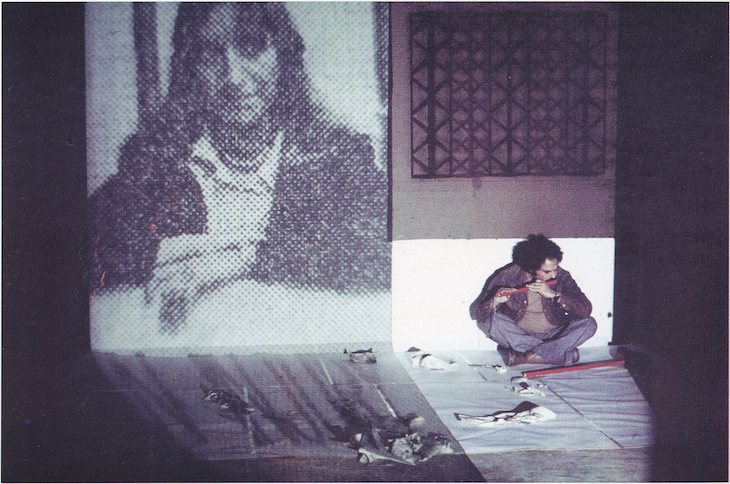
Paki Bastard (Portrait of an Artist as a Black Person) (1977), Rasheed Araeen. Courtesy the artist
Despite his upcoming celebration by the art establishment, Araeen remains unashamedly radical. He tells me that six months ago he was offered an OBE for his contribution to British culture, a gesture he dismissed as ironic considering a career spent criticising the politics of neocolonialism. ‘The basic issue in Britain today is the legacy of its colonial past,’ he explains. ‘While colonised countries got so-called independence, the occupiers never went through decolonisation. And I don’t want to participate in the imperial view of Britain, but to question it.’ He has explored these questions in the polemical yet scholarly journal, Third Text, of which he was the founding editor (1987–2011), and it is for this celebration of marginal discourse that he is perhaps best known. He continues to propose new solutions in his recent writing and work, which sketch ambitious blueprints for new societies brought about by collective action.
Rasheed Araeen was born in 1935, in humble circumstances in a small town in the Pakistani desert. His ‘non-literate peasant mother,’ he says, ‘would sometimes prepare a lump of wet clay’ so that he could make his own toys. When he was a teenager, the family moved to Karachi, where ‘there were no art schools, no museums, no art galleries, no nothing’. He stumbled across a book on Frank Lloyd Wright in the library of the United States Information Service library, where he had joined an art club, and got his first exposure to modernism. While studying engineering at university, he experimented with abstract painting (Ham Raqs, 1959) and, by burning and twisting bicycle wheels, made his first forays into sculpture (My First Sculpture, 1959). He decided to give up a promising future in engineering and head to the West to pursue life as an artist. ‘There was a lot of resistance from my family, but I kept on lying to them,’ he chuckles. ‘When I left Karachi for Paris, I told them I was going there to study architecture.’
After a brief hiatus in Paris, which failed to live up to his romantic expectations, Araeen moved to London, where he lived in a Chelsea bedsit, got a menial job in the Golden Egg restaurant and absorbed himself in the work of Bridget Riley, Caro, and the New Generation of British sculptors. He also suffered a brief spell of intense delusions that he later described as schizophrenia, hallucinations that incubated a new artistic direction. ‘I went into a state of some kind of trance, which sometimes happens to me,’ he says. ‘I saw a big steel structure, almost 100-feet cubed, made of lattices, for no purpose, and with staircases by which people would climb up and down. I could never have built that structure – who would fund it? But the cubes I drew and made afterwards are a fragment of it.’
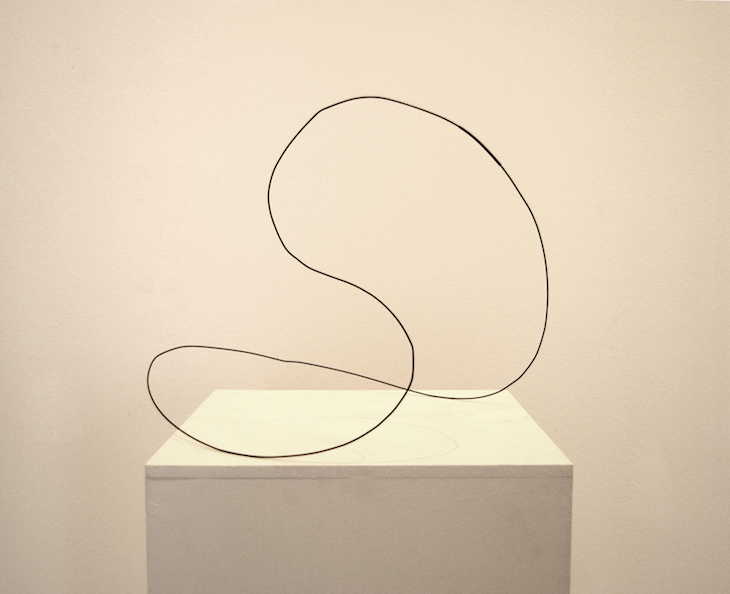
My First Sculpture (1959), Rasheed Araeen. Courtesy Aicon Gallery
Araeen, who was by then working for British Petroleum as an engineering assistant, and still without a studio, began to realise these cuboid forms, maquettes such as First Structure (1966–67), on his kitchen table. The ‘Primary Structures’ exhibition at the Jewish Museum in New York in 1966 introduced minimal art to a broad public – with work by Caro, Carl Andre, Donald Judd and Dan Flavin – and Araeen shared their interest in simplified geometry and industrial effects. Cube as Sculpture, his drawing of that same year, shows multiple images of an aluminium box, divided in different ways with translucent glass. And in Zero to Infinity (1968–2007), now in the collection of the Tate, he encouraged an audience to rearrange 100 of his brightly-coloured wooden building blocks into ever-changing configurations.
Araeen’s lattice pieces were inspired by 19th-century bridges, and the space frames with which he helped construct many of BP’s industrial units. Indeed, many of Araeen’s works from that period, some of which hang suspended in space, resemble the structural bones of Alexander Graham Bell’s giant tetrahedral kites, with which he invented the space frame. This modular, lightweight architectural element, which can span large spatial areas, gave rise to the utopian megastructural fantasies of the 1960s, underpinning the fluid architecture of Cedric Price’s Fun Palace, Constant Nieuwenhuy’s New Babylon and Archigram’s Plug-in City. At the same time, Araeen’s latticework arrangements became increasingly ambitious, and they share this spirit of technological optimism.
One of his wall structures, Boo, won him a prize at John Moore’s Liverpool Biennale in 1969. Studio International published a picture of Araeen alongside the work, wearing a tie that is as wide as his handlebar moustache. ‘I thought it was the opening for me to enter the art market,’ Araeen says of his award. By then, he had given up his engineering job, and taken up a studio in St Katharine Docks in East London, where he staged his first public happening, Chakras (1969–70), in which the audience were invited to throw 16 large orange discs into the water, from where they floated into the Thames. ‘I went around looking for galleries and everywhere I received a “No”. One gallerist who was very interested in my work, to the point of fascination, spent an hour in my studio but, when I asked if he’d exhibit me, I was told that he only showed American or English artists. In the face of such prejudice, I came to the conclusion that something was very, very wrong with the art market.’
Under the influence of the Filipino artist David Medalla, who had also moved to London in the early 1960s and cofounded the avant-garde Signals Gallery, Araeen’s work became more overtly interventionist and political. ‘We met in 1971, and used to talk about art, and its function in society, which was not sympathetic to us, as well as Marx and Mao. This was the beginning of my political awakening.’ He absorbed himself in Frantz Fanon and other anti-colonial writers such as Amílcar Cabral and Paulo Freire, and battled what they described as the dehumanising effects of internalised oppression. He put together the Black Panther Movement’s newsletter, which they distributed outside Brixton underground station and in the market, and the collages he made at the time – such as For Oluwale (1971–73), dedicated to a Nigerian who was found drowned after being tormented by police in the same year as Enoch Powell’s ‘Rivers of Blood’ speech – take on the urgency of these radical pamphlets.
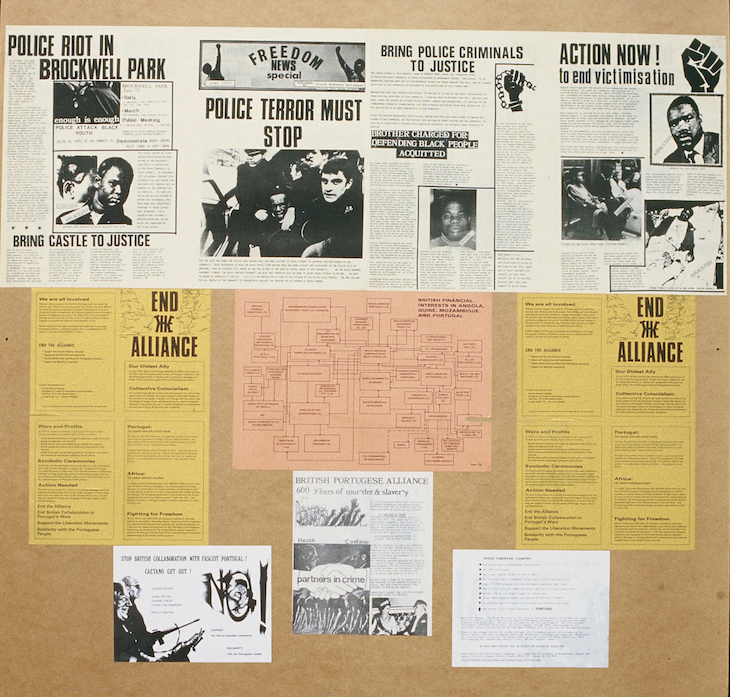
For Oluwale (detail; 1971–75) Rasheed Araeen. Courtesy the artist
Araeen increasingly put himself into his work, evident in his first one-person show in 1975, when he was 40, at David Medalla’s new organisation, Artists for Democracy, of which Araeen was a member. In the performance Paki Bastard, he gagged himself and wore dark glasses, which gave him the menacing air of a bank robber or bandit. For Burning Ties (1976–79), dressed in black and with a leather glove on his right hand, he burned a row of red neckties, an obvious symbol of authority (in another piece the American Flag also went up in smoke). His painted collages, such as Coloured (1979), feature his distinctive mop of black hair, with his face either bleached or blacked out; in others his features are hidden behind provocations in Urdu, graffiti that abused a neocolonial class of functionaries and collaborators. ‘They’re not self-portraits,’ he says, ‘but about the impossibility of defining yourself in a racist society.’
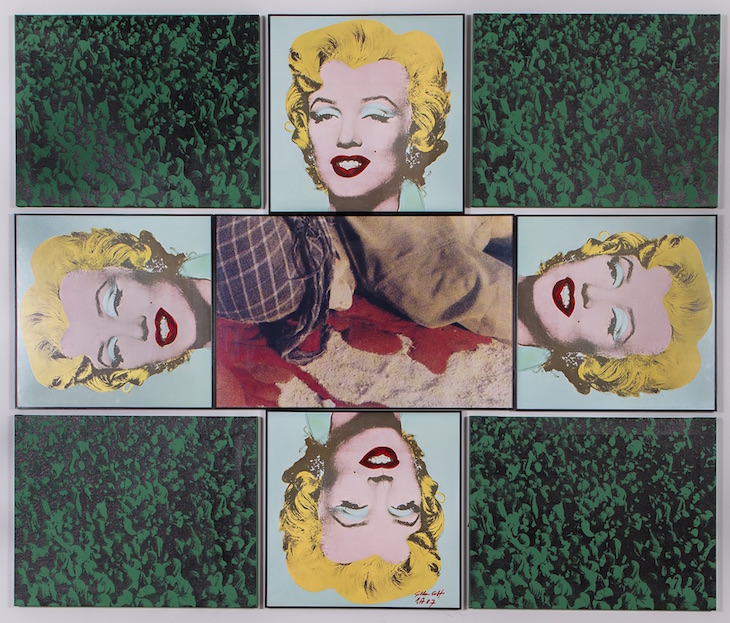
Golden Calf (1987), Rasheed Araeen. Courtesy the artist and Rossi & Rossi, Hong Kong
In the 1980s, Araeen critiqued the politics of Eurocentrism, and the ideological implications of modernism, with a series that made transgressive play with the modernist grid. The first of these nine-panel works, Fair and Lovely (1985), featured ads for whitening cream that he spotted in Karachi, which he gridded together with the faces of Asian models, made-up so as to look white and Westernised. Golden Calf (1987) draws on Andy Warhol’s little known trip to Iran in 1976, juxtaposing his Marilyn multiples with the body of a victim of the Iraq-Iran war, lying face down in a pool of blood. To give context, each work includes Urdu headlines clipped from national newspapers, recording events like Benazir Bhutto’s house arrest, Richard Nixon’s visit to Pakistan, and Margaret Thatcher’s anti-immigration speech of 1978.
However, there was always a continuity with his minimalist structures, and in Paki Bastard his space frames were projected on to his body, like the bars of a cell; they appear in the background of Burning Ties, and as a framing device in many of his triptychs, such as Look Mamma… Macho! (1983–86). His original hallucination of a Piranesi-like lattice tower was almost realised in his biggest work to date, To Whom It May Concern, shown outside the Serpentine in 1996. This huge box-like construction, containing over a thousand metre-cubed modules, was made of scaffolding and over 40-foot-high. The architectural matrix continues to absorb him, and space frames – decorated with large diamonds of blue, red, yellow and green – fill his studio as he prepares for his large-scale commission for the Aga Khan Foundation.
I ask Araeen if age has tempered his politics, and if the anger of his earlier, charged works has any place in the brightly-coloured Opus series of canvases that he’s currently working on, and which have the joyful, patterned exuberance of television test cards. In response, he shouts to his studio manager to fetch me a copy of Art Beyond Art (2010), and tells me, ‘I have formulated my new ideas in this book: you will find all your answers here’. Written 35 years after ‘Black Manifesto’ railed against the institutional racism of the art market, it is subtitled ‘Ecoaesthetics: A Manifesto for the 21st Century’. It makes an impassioned plea for the power of ‘collective creativity’ in response to the art world’s ‘global spectacle of fetishism’ and the ‘life-threatening damage of capitalism’.
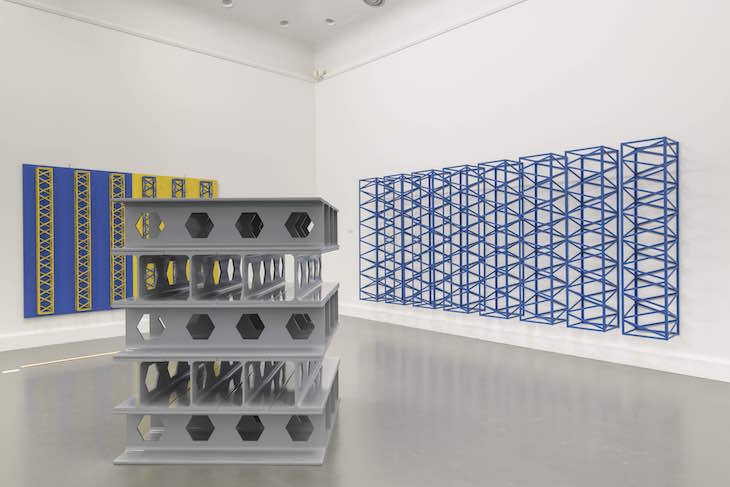
Installation view,‘Rasheed Araeen: A retrospective’, at the Van Abbemuseum, Eindhoven, 2017 Photo: Peter Cox; courtesy the artist
Art Beyond Art is part memoir and part meditation on the perceived failure of both the class struggle and the avant-garde, as well as a testament to Araeen’s belief in the untapped power of collective action. He proposes a series of utopian schemes, seen in the context of Land Art and presented with complete sincerity. In one possible scenario, he imagines all the countries of Europe, Asia and Africa that border the Mediterranean coming together in one political Union, based on their shared heritage, to collaborate, cooperate, and exchange – thereby offering ‘a model for the unity of the world’. Another proposes the damming of a river in Balochistan to revitalise 2000 acres of formerly barren land, a socially meaningful action that he would transfer to the community so that they could continue to develop it as an artwork.
He also calls for the creation of a collective farm in Africa, with the resources to maintain a hundred families, which would become a Pan-African centre for research in agriculture and sustainability. He imagines the greening of the Sahara, and has created blueprints (whose gridded structures resemble his paintings) that envision this being achieved using solar energy to pump water from the ocean to desalination plants. A band of such farms could provide employment as well as food for the whole continent. They would be run on communistic principles, with no private property or hierarchies of power. ‘This is the only way humanity as a whole can now move forward to save the earth from total disaster and pursue a better future for all life on earth,’ he writes.
While such artistic utopias have obviously gone unrealised, Araeen has incorporated their egalitarian, non-hierarchical principles into his recent work. For Documenta 14 in Athens, Araeen staged Shamiyaana—Food for Thought: Thought for Change (2016–17), for which he built a series of multicoloured canopies, inspired by Pakistani wedding tents, that were decorated with the geometric patchwork that one sees in his paintings. Twice a day, 60 passersby were invited to sit down to a free meal with strangers, including many immigrants who had crossed the Mediterranean. It was imagined as something of a test case for his communistic Union, which he called ‘Mediterranea’.
‘My use of geometry involves symmetry,’ Araeen says, connecting his Opus paintings to his visions of possible cooperative futures. ‘If you perceive the organisation of society on a more symmetrical basis, of course it involves politics. If I have time, I will make such a farm, arranged symmetrically – people will live there, use their land to produce food, and distribute it symmetrically.’ He looks at me directly, and his eyes seem to well and glisten for piercing emphasis. ‘There is an element of optimism in my work. For a vision for the BETTER world.’
‘Rasheed Araeen: A Retrospective’ is at the Van Abbemuseum, Eindhoven, until 25 March.
From the January issue of Apollo. Preview and subscribe here
Unlimited access from just $16 every 3 months
Subscribe to get unlimited and exclusive access to the top art stories, interviews and exhibition reviews.


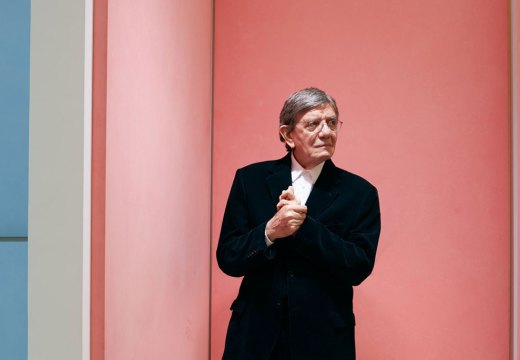
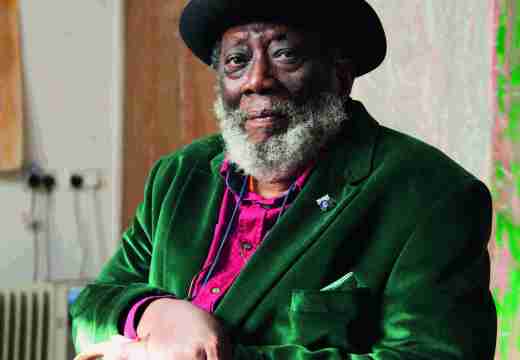
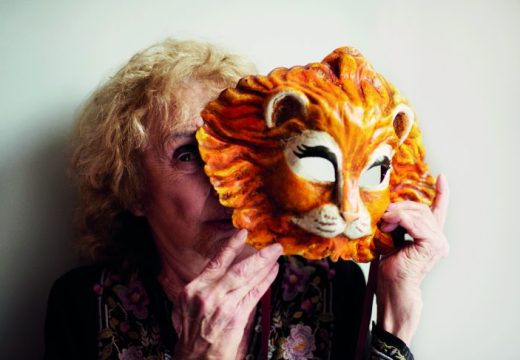









![Masterpiece [Re]discovery 2022. Photo: Ben Fisher Photography, courtesy of Masterpiece London](http://www.apollo-magazine.com/wp-content/uploads/2022/07/MPL2022_4263.jpg)
It’s time for the government of London to return to its rightful home